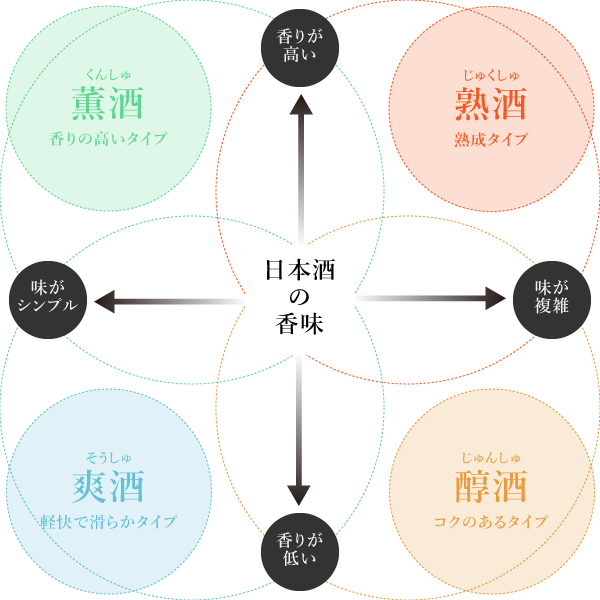4 Types of Japanese Sake Their Characteristics and Food Pairings
2020.11.03

The beginners may wonder how different each type of sake tastes or smells. Learning about each flavor and aroma will help you enjoy sake more.
Japanese sake is classsified basically into 4 types, based on the flavors and aromas.
There are ”fruity,“ “ light and smooth,“ “ full-bodied,“ and “ matured types.“ The characteristics of each type are as follows:

“Kun-shu“ Fruity type
Aroma : Features gorgeous aromas of fruit or flowers, and has a sense of clarity.
Taste : Has moderate sweetness and roundness, balanced with a refreshing acidity.The brilliant aroma and refreshing flavor are characteristics of this type of sake.
・Namely, “ginjo-shu“ and “daiginjo-shu“ belong to this type.
・Recommended temperatures are between 10 to 16℃ (50 to 61℉).It can be drunk as nuru-kan if you would like the balance of sweetness and sourness.
・Since its aromas are main features, it doesn’t pair well with strong flavored dishes. It’s recommended as an aperitif.
“So-shu“ Light and Smooth type
Aroma : Features a mild and moderate aroma.
Taste : Has a refreshing taste and a smooth feeling in the mouth.Pure aroma and light taste are characteristics of this type of sake.It’s also expressed “ tanrei (light and delicate taste) “.
・Nama-zake, freshly pressed sake, and low-alcohol sake belong to this type.
・Recommended temperatures are around 6 to 10℃ (43℃ to 50℉).The range of proper temperatures for drinking is narrow.
・This type of sake pairs well with many kinds of dishes except fatty foods.It’s good as an aperitif, and with meals.
“Jun-shu“ Full-bodied type
Aroma : Features a natural wood scent, or an aroma conveying umami, like dairy products.
Taste : Features sweetness, acidity, a pleasant bitterness, and a well-rounded richness.
・It has pleasant bitterness and well-rounded taste.Junmai-shu, kimoto- (a traditional starter cultures with natural lactic acid) style junmai-shu, and honjozo-shu belong to this type.
・It can be drunk at 10 to 45℃ (50 to 113℉), the widest range of temperatures.You can enjoy the changes in tastes across “ hana-hie “ to “jo-kan.”
・It pairs well with a huge range of foods. It is best to drink during meals.It doesn’t match well with light and delicate foods.
“Juku-shu“ Matured type
Aroma : Features strong and complex aromas, like spices and dried fruit.
Taste : Has thick sweetness balanced with an acidity mellowed by maturation.
・It is characterized by abundant aromas and full-bodied taste.Some of this type of sake are dark-colored and brownish.
・Ko-shu (aged sake), choki-chozo-shu (long aged sake), and hizo-shu (tresured sake) belong to this type.
・It can be drunk at 7 to 25℃ (45 to 77℉), a wide range of temperatures.
・Since this type of sake has a distinctive and very strong taste, it pairs well with well-seasoned, and rich-flavored dishes.It’s better to avoid raw seafood.
Recommended dishes for each type of sake
| Fruity Sake | Light and Smooth Sake | Full-Bodied Sake | Matured Sake | |
| Wa-shoku (Japanese food ) |
・Seabass or ayu fish grilled with salt ・Vegetable tempura ・Grlled sea eel ・Grilled Japanese beef served with tare sauce And more |
・Raw oysters ・Dashi-maki tamago (seasoned omelet), and Chawan-mushi (steamed egg custard with assorted ingredients) ・Furofuki daikon (boiled white radish served with miso sauce) And more |
・Chikuzen-ni (simmered root crops with soy sauce) ・Saba-no-miso-ni (simmered mackeral with miso) ・Yakitori (grilled chicken glazed with tare sauce) And more |
・Unagi-no-kabayaki (eel broiled in soy-based sauce) ・Tai-no-ara-ni (simmered bony parts of red snapper ) ・Buta-no-kaku-ni (braised diced pork) ・Smoked foods And more |
| Yo-shoku ( Western food ) |
・Shrimp avocado salad1 ・Seafood gratin ・Chowder And more |
・Seafood salad ・Plain omelet ・Cabbage rolls stuffed with minced meatAnd more |
・Hamburger ・Steak ・Fried chicken ・Cheese And more |
・Stewed beef ・Roasted duck ・spaghetti bolognese And more |
| Chu-ka (Chinese food ) |
・Bang bang ji ( chicken in spicy sauce ) ・Chop suey ・Sprong rolls And more |
・Bean-starch vermicelli salad ・Crabmeat omelet ・Stir-fried squid And more |
・Gyoza ・Sweet and sour po ・Mapo Tofu (Szechwan style tofu in spicy sauce ) And more |
・Beijing duck ・Century eggs ・Stir-fried beef in oyster sauce |
| unfavorable dishes | strong flavored dishes | fatty dishes | light and delicate dishes |
raw seafood dishes |

